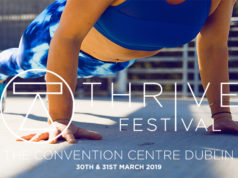

An overview of Kinesio Tape, the latest trend in injury management “Something better than any laser, wrap, or electric massager…The Tape. It is a special hot-pink athletic tape that came from Japan and seemed to have special powers. Every morning before the stage, they would tape us all up, different parts of our bodies…George’s back, Chechu’s knees. Sometimes we’d be so wrapped up in hot-pink tape that we’d look like dolls, a bunch of broken dolls. But the next day the pain disappeared–it was gone.” by Lance Armstrong, From ‘Every Second Counts’
Kinesio Tape exploded into popularity and public eye when 50,000 rolls were donated to the 2008 Beijing Olympics, and athletes wearing the bright pink, blue or black tape were on shown on TV. Since then is it being used by teams and therapists world wide and you’ll more than likely see it on athletes in a race you have competed in.
It was developed in the 1970s in Japan by Dr. Kenzo Kase who was looking for a tape that would heal traumatised tissue. He found that traditional taping methods provided muscle and joint support but reduced the range of motion, compressed fascia, and restricted movement of fluid thereby inhibiting the healing process.
The popularity of Kinesio tape is due to its elastic and non restrictive nature. There are specific techniques to apply the tape that allows the tape be used for multiple purposes. Its uses include:
- Supporting weaker muscles
- Relax tight muscles
- Speed up the removal of swelling and bruising
- Pain relief
- Correcting biomechanical problems e.g. correcting joint alignments
- Providing sensory feedback for postural awareness and alignment
When pain or stiffness is felt in muscles it is due to activation of pain receptors by localised inflammation. If you have a fall or accident more obvious swelling or bruising occurs. In both cases the tape works by lifting the skin which can reduce swelling, increase circulation, releasing some of the fascia, and reduce pain by taking pressure off pain receptors.
The tape is applied directly over the muscle when the muscle is on stretch. When the muscle relaxes the tape pulls on the skin which sometimes can be seen as small crinkles in the tape. If most of the stretch is taken out of the tape, it can function as a structural tape to support weak or mal-tracking joints, like the white tape you see on knees and ankles.
When the tape is applied, athletes will often be able to notice a difference between a taped muscle on one side and the non taped muscle on the other side. They often report a feeling of lightness, or support. Because the tape is flexible (it can stretch 130-140% of its original length) and applied while the muscle is stretched to its end range it does not affect flexibility or range of movement. It is breathable, and can be worn for 3-5 days without coming off in the shower or due to sweat.
There is no difference in the different coloured tapes. As well as pink, blue and black, the tape also comes in beige which may be more discrete under a white shirt at work!
At present there aren’t many clinical studies into the effectiveness of Kinesio tape. Two studies on the shoulder found that Kinesio tape did improve activation of the muscles around the shoulder blade, and range of movement in the shoulder. Another study showed that Kinesio tape applied to the vastus medialis (quad muscle on the inside of the knee) increased is bioelectrical activity for 24 hours while the tape was applied, and for a further 48 hours after the tape was removed. This would be of interest to those with knee pain as the vastus medialis is the muscle above the knee towards the inside which can often be found to be weak in athletes with knee pain. From my own experience in the clinic I think it is great tool to help athletes rehabilitate quicker and they seem to like it too.
So when would you consider using the tape:
- If you have a muscle that is niggling when training or racing and you want to support it so you can keep on going.
- If you crash or have a trauma with swelling or bruising, taping will clear this quicker than non taping as it will lift the skin and encourage its removal 24hrs a day. This would be important where the swelling or bruising is restricting your range of movement, or causing you pain affecting training, racing or your daily life
- If you have an issue with a joint, for example the kneecap is not tracking correctly in its groove, Kinesio tape applied for the duration of a training session or race may give some pain relief.
Like with all things, the Kinesio tape is not a magic bullet and has best effects when combined with a treatment and rehabilitation programme.
For pictures of athletes wearing the tape here are some pictures from the 2008 Olympics: www.kinesiotaping.com/olympic-watch.php
References:
- Fu TC, Wong AM, Pei YC, Wu KP, Chou SW, Lin YC. 2008 Effect of Kinesio taping on muscle strength in athletes-a pilot study. Journal of Science and Medicine in Sports. 11 pp. 198-201.
- Hsu YH, Chen WY, Lin HC, Wang WT, Shih YF. 2009 The effects of taping on scapular kinematics and muscle performance in baseball players with shoulder impingement syndrome. Journal of Electromyography and Kinesiology. 19 pp. 92-9
- Thelen MD, Dauber JA, Stoneman PD 2008. The clinical efficacy of kinesio tape for shoulder pain: a randomized, double-blinded, clinical trial. Journal of Orthopeadic and Sports Physical Therapy 38 pp.389-95
Kinesio Tape exploded into popularity and public eye when 50,000 rolls were donated to the 2008 Beijing Olympics, and athletes wearing the bright pink, blue or black tape were on shown on TV. Since then is it being used by teams and therapists world wide and you’ll more than likely see it on athletes in a race you have competed in.
It was developed in the 1970s in Japan by Dr. Kenzo Kase who was looking for a tape that would heal traumatised tissue. He found that traditional taping methods provided muscle and joint support but reduced the range of motion, compressed fascia, and restricted movement of fluid thereby inhibiting the healing process.
The popularity of Kinesio tape is due to its elastic and non restrictive nature. There are specific techniques to apply the tape that allows the tape be used for multiple purposes. Its uses include:
- Supporting weaker muscles
- Relax tight muscles
- Speed up the removal of swelling and bruising
- Pain relief
- Correcting biomechanical problems e.g. correcting joint alignments
- Providing sensory feedback for postural awareness and alignment
When pain or stiffness is felt in muscles it is due to activation of pain receptors by localised inflammation. If you have a fall or accident more obvious swelling or bruising occurs. In both cases the tape works by lifting the skin which can reduce swelling, increase circulation, releasing some of the fascia, and reduce pain by taking pressure off pain receptors.
The tape is applied directly over the muscle when the muscle is on stretch. When the muscle relaxes the tape pulls on the skin which sometimes can be seen as small crinkles in the tape. If most of the stretch is taken out of the tape, it can function as a structural tape to support weak or mal-tracking joints, like the white tape you see on knees and ankles.
When the tape is applied, athletes will often be able to notice a difference between a taped muscle on one side and the non taped muscle on the other side. They often report a feeling of lightness, or support. Because the tape is flexible (it can stretch 130-140% of its original length) and applied while the muscle is stretched to its end range it does not affect flexibility or range of movement. It is breathable, and can be worn for 3-5 days without coming off in the shower or due to sweat.
There is no difference in the different coloured tapes. As well as pink, blue and black, the tape also comes in beige which may be more discrete under a white shirt at work!
At present there aren’t many clinical studies into the effectiveness of Kinesio tape. Two studies on the shoulder found that Kinesio tape did improve activation of the muscles around the shoulder blade, and range of movement in the shoulder. Another study showed that Kinesio tape applied to the vastus medialis (quad muscle on the inside of the knee) increased is bioelectrical activity for 24 hours while the tape was applied, and for a further 48 hours after the tape was removed. This would be of interest to those with knee pain as the vastus medialis is the muscle above the knee towards the inside which can often be found to be weak in athletes with knee pain. From my own experience in the clinic I think it is great tool to help athletes rehabilitate quicker and they seem to like it too.
So when would you consider using the tape:
- If you have a muscle that is niggling when training or racing and you want to support it so you can keep on going.
- If you crash or have a trauma with swelling or bruising, taping will clear this quicker than non taping as it will lift the skin and encourage its removal 24hrs a day. This would be important where the swelling or bruising is restricting your range of movement, or causing you pain affecting training, racing or your daily life
- If you have an issue with a joint, for example the kneecap is not tracking correctly in its groove, Kinesio tape applied for the duration of a training session or race may give some pain relief.
Like with all things, the Kinesio tape is not a magic bullet and has best effects when combined with a treatment and rehabilitation programme.
For pictures of athletes wearing the tape here are some pictures from the 2008 Olympics: www.kinesiotaping.com/olympic-watch.php
References:
- Fu TC, Wong AM, Pei YC, Wu KP, Chou SW, Lin YC. 2008 Effect of Kinesio taping on muscle strength in athletes-a pilot study. Journal of Science and Medicine in Sports. 11 pp. 198-201.
- Hsu YH, Chen WY, Lin HC, Wang WT, Shih YF. 2009 The effects of taping on scapular kinematics and muscle performance in baseball players with shoulder impingement syndrome. Journal of Electromyography and Kinesiology. 19 pp. 92-9
- Thelen MD, Dauber JA, Stoneman PD 2008. The clinical efficacy of kinesio tape for shoulder pain: a randomized, double-blinded, clinical trial. Journal of Orthopeadic and Sports Physical Therapy 38 pp.389-95






